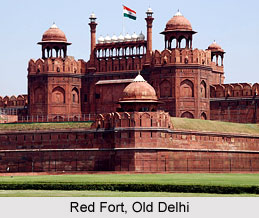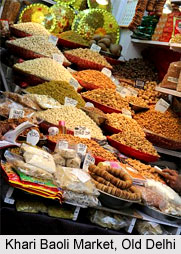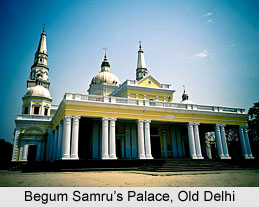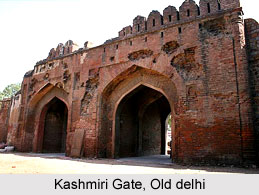 Old Delhi was known as Shahjahanabad and is a walled city of the national capital of India, namely, New Delhi. The Mughal emperor Shah Jahan had founded the region of Shahjahanabad in the year 1639. Old Delhi continued to be the capital of the Mughal rulers, until the downfall of the Mughal Dynasty. During the regime of the Mughals and even thereafter, Old Delhi housed numerous marvellous gardens and mosques, along with bungalows of influential nobles and members of the court of the emperors. Though the area of Old Delhi is overcrowded, it still is the nerve centre of the city of Delhi.
Old Delhi was known as Shahjahanabad and is a walled city of the national capital of India, namely, New Delhi. The Mughal emperor Shah Jahan had founded the region of Shahjahanabad in the year 1639. Old Delhi continued to be the capital of the Mughal rulers, until the downfall of the Mughal Dynasty. During the regime of the Mughals and even thereafter, Old Delhi housed numerous marvellous gardens and mosques, along with bungalows of influential nobles and members of the court of the emperors. Though the area of Old Delhi is overcrowded, it still is the nerve centre of the city of Delhi.
History of Old Delhi
The southern portion of Shahjahanabad is being overlapped by the area where Tughlaqs used to reside in the 14th century, when this region was the power seat of Delhi Sultanate. During the rule of Shah Jahan, the founder of Old Delhi city, the city was walled from 1638 to 1649. Chandni Chowk and Lal Qila were important places in Old Delhi. The original cantonment of Delhi was Daryaganj. The Raj Ghat Gate existed on the eastern side of Daryaganj and the entrance of this gate was near Yamuna River. Chawri Bazar was the very first wholesale market of the region of Old Delhi which was found in 1840. This, however, was mainly a hardware market. The Khari Baoli market, which was found in 1850 sold herbs, spices and dry fruits. In 1869, the `Phool Mandi` or Flower Market came into existence.

Following the decline and subsequent downfall of the Mughal Empire after the Sepoy Mutiny in 1857, the British Raj moved its capital from Old Delhi to the city of Kolkata in the state of West Bengal. Immediately after the declaration of the new capital of India, Lutyens` Delhi was developed by the British near the south-western part of Shajahanabad. From this time onwards, the older parts of the city started being referred to as `Old Delhi` since Lutyens` Delhi was the new seat of the national government of the nation. In 1931, the city was officially inaugurated.
Old Delhi in Post Mughal Period
There were two main roads, one of which spread from Lahore Gate of the city of Old Delhi to the Lahore Gate of the citadel. The other shorter road led to the Lahore Gate of the fort from the Delhi Gate. The streets were divided into two parts, which had two different names. The portion of the road between the entry point of the street and Lahore Gate is termed as `Dariba` or `Khuni Darwazah` or the `Military Bazar`. The street which was present between the current Kotwali or the Head Police Station of Old Delhi was named as `Phul Ka Mandi` or the flower market. The homes which were built in front of the Kotwali were a small distance from the remaining houses in the street, which made the area resemble a square.
 The Jewellers` Bazar or the `Jauhari` was existent between the Taraiah Gate and the Kotwali. Their neighbourhood was referred to as `Asharfi ka Katra` and was equally famous as the Chandni Chowk. The houses which were built near Chandni Chowk were of similar heights and were decorated with painted verandahs and arched doors. There were two gateways which were existent in the southern and northern parts of the square led to the Sarai of Jahanara Begum. In the middle of the Chowk, there was a Municipal Chowk. Fruits stalls, vegetable stalls and sweetmeat stalls were present in the region around the tank. The daughter of Shah Jahan, Jahanara Begum was said to have built this street. The street extended from Chandni Chowk from Lahore Gate and measured about 40 yards in width.
The Jewellers` Bazar or the `Jauhari` was existent between the Taraiah Gate and the Kotwali. Their neighbourhood was referred to as `Asharfi ka Katra` and was equally famous as the Chandni Chowk. The houses which were built near Chandni Chowk were of similar heights and were decorated with painted verandahs and arched doors. There were two gateways which were existent in the southern and northern parts of the square led to the Sarai of Jahanara Begum. In the middle of the Chowk, there was a Municipal Chowk. Fruits stalls, vegetable stalls and sweetmeat stalls were present in the region around the tank. The daughter of Shah Jahan, Jahanara Begum was said to have built this street. The street extended from Chandni Chowk from Lahore Gate and measured about 40 yards in width.
The canal of `Ali Mardan` was present in the centre of the street and was under the shade of trees. A city hall has replaced the Sarai of Jahan Ara Begum. The Gurdwara Sis Ganj Sahib is located near the Kotwali.
Culture in Old Delhi
Mughlai cuisine, as well as vegetarian cuisine is popular in Old Delhi. The Paranthe Wali Gali and Ghantewala Halwai are quite renowned for its foodstuffs. There are numerable restaurants in areas near Jama Masjid, Chitli Qabar, Balli Maran and others. Street food of Old Delhi is also immensely popular and savoured by the local inhabitants and tourists. Spicy `chaats` and tangy snacks available in shops near Chawri Bazar and Chandni Chowk can be relished by people.
 Tourism in Old Delhi
Tourism in Old Delhi
Old Delhi is home to innumerable historical spots, which are thronged by millions of tourists throughout the year. The Red Fort and the region of Chandni Chowk are interesting tourist locales in Old Delhi. The Jama Masjid, Khari Baoli which is the biggest spice market in Asia, the tomb of Razia Sultana near Kalan Masjid, Rajghat, St. James Church which is the oldest church of Delhi, Fatehpuri Masjid, Haveli of Zeenat Mahal and Gali Qasim Jan are some of the tourist destinations in Old Delhi. Other exciting historical mansions include the Haveli of Mirza Ghalib in Lal Kuan Bazar, Chunnamal Haveli near Katra Neel, Palace of Begum Samru, Haveli Naharwali, Naughara Mansions in Kinari Bazar, Haksar Haveli, Kucha Chelan and Khazanchi Haveli.
Old Delhi is also famous for its several walls and gate which are of historical significance. The city of Old Delhi was constructed in a quarter circle and was surrounded by as many as 14 gates. The total area occupied by Old Delhi was 1500 acres. Mori Gate in the northern part of Old Delhi, Kabuli Gate in the western side of Old Delhi, Lahori Gate towards the western end of Old Delhi, Kashmiri Gate on the northern part of Old Delhi, Nigambodh Gate on the north-eastern part of Old Delhi, Ajmeri Gate on the south-eastern part of Old Delhi, Turkman Gate in the south-eastern end of Old Delhi and Delhi Gate in the southern end of Old Delhi are the various gates of Old Delhi. Though some of these gates are in ruins today, a majority of these gates are still existent today. Khuni Darwaza was a renowned gate here, which was created by Sher Shah Suri.






